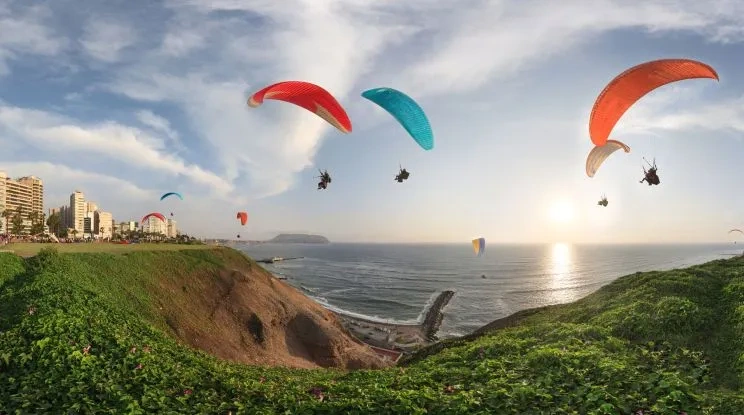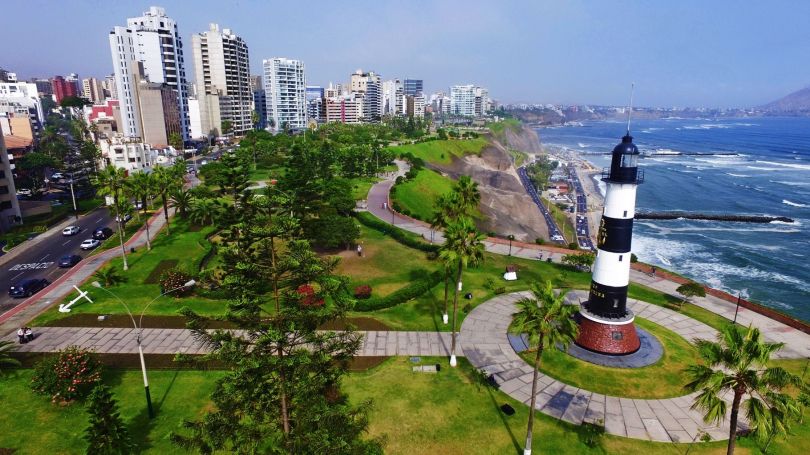Paragliding in Lima: a complete guide to flying over the Costa Verde

Long-form guide for 18–35 travelers who want to see Lima from above, with zero prior experience.
Short on time in the Peruvian capital and craving something easy to book, safe and memorable? Paragliding along the Costa Verde is a no-brainer. Lima is the only South American capital that faces the Pacific Ocean, and that single fact sets up perfect conditions: tall cliffs, steady sea breeze and an urban skyline that ends abruptly at the water. On a tandem flight you don’t need to know anything—your certified pilot handles takeoff, controls and landing. Your job is simple: follow brief instructions and enjoy.
1) Why Lima is genuinely a unique place to fly
Lima isn’t your average seaside city. It sits on 70–100 m coastal cliffs directly above the Pacific. Between the upper rim (the malecón) and the beach runs the Costa Verde expressway, a road tracing the base of the cliffs and linking several districts. That geography creates something very practical for flying: laminar wind coming from the ocean that, when it hits the cliff, produces dynamic lift. Result: smooth, predictable flights and wide views from the very first minute.
What you’ll see up there:
The never-ending Pacific Ocean and its white surf curving along the shore.
Lima’s skyline with parks, seaside promenades and buildings perched on the edge.
The Costa Verde traffic miniaturized, cars looking like Hot Wheels from above.
Southbound: the bohemian edge of Barranco and the outline of the Morro Solar; northbound: the coast toward Magdalena and San Miguel.
One more thing about scale: greater Lima tops 10 million people. Flying gives you a mental map of the city you’ll use for the rest of your stay.
2) The Costa Verde from north to south: where you fly and what you’ll see
While the heart of tourist flights is Miraflores (at the Parque Antonio Raimondi paragliding site), the Costa Verde is a long strip. Use this mental map:
San Miguel / Magdalena del Mar
Up on the northern side. Launch areas activate when the wind lines up just right. Views open toward the bay and, on clear days, you can sense the Callao port area further on. Less known to visitors, more local flavor.
Miraflores (Raimondi Paragliding Site)
The classic spot: easy logistics, services all around and a pristine promenade. You take off from the cliff, glide past photogenic parks like the Parque del Amor and ride the coastline in either direction depending on wind. This is where most first-timer flights happen.
Barranco
Lima’s artsy district. When conditions allow you to push south, you’ll catch views of republican-era houses, murals and a coastline with personality. The Puente de los Suspiros sits inland, but Barranco’s vibe is obvious even from the air.
Chorrillos
Further south, with the Bay of Chorrillos and the Morro Solar hill as backdrop. On good days you get frames that mix sea, hills and the city in one shot.
Tip: if it’s your first flight, Miraflores is usually the simplest option for access and operator availability. If you’re sent to another point, great—just confirm the exact location and how to get there.
3) No experience needed: how a tandem works
A tandem means you fly attached to a licensed pilot’s harness. The flow is usually like this:
Check-in and weigh-in. Helps adjust harness and wing to your size.
Briefing (3–5 minutes). How to run for takeoff, how to sit back afterward and what landing feels like.
Gear. Helmet, comfy seated harness and a windbreaker if it’s breezy.
Takeoff. A few firm steps downhill; when the wing is pressurized your pilot calls “run”—seconds later you’re airborne.
Flight. Typically 8–15 minutes (depends on wind). Chat, ask for gentle turns or—if you’re into thrills and the day allows—slightly more dynamic moves.
Landing. Usually back where you started or down on the beach, depending on conditions.
Let’s kill a myth: you don’t jump into a void and there’s no freefall. A paraglider is a wing; it floats on air like an oversized bird. Your role is to follow cues and enjoy.
4) Safety, for real: how to choose with a clear head
Responsible operators. Ask about certifications and gear maintenance (harness, lines, wing and reserve parachute). Good operators are happy to show and explain.
Weight & age limits. There are working ranges (e.g., 40–100 kg) that depend on wind and wing model. Minors generally fly with authorization.
Insurance. Check for liability and personal accident coverage.
Wind rules everything. If you’re told “no flying today,” it’s a safety call. Neither blue skies nor your schedule changes the physics.
Self-check. Skip flying with recent neck/back injuries, strong vertigo or if you feel sick. Eat light beforehand.
Useful rule: a good pilot cancels early. Don’t let FOMO push you—the best day is the safe day.
5) When to go: seasons, garúa and the best hours
Lima runs on a very particular coastal microclimate:
Summer (December–April). Sunnier days, bright blue backgrounds. Wind can be light to moderate—great for beginners.
Autumn–winter (May–November). Expect garúa (fine mist and gray skies). Photos look moodier, but the wind often stays consistent and very flyable.
As for time of day, afternoons often deliver more consistent conditions, but it’s day-by-day. Operators open and close windows based on wind strength and direction. If your itinerary is tight, grab the first good wind window and keep a Plan B in case it changes.
6) Simple logistics: getting around and what to bring
Getting to Miraflores (Raimondi site)
If you’re staying in Miraflores, you can walk along the malecón.
From Barranco, a taxi/app ride is 10–20 minutes depending on traffic.
From the Historic Center, allow 30–45 minutes off-peak (more at rush hour).
Other points
When San Miguel/Magdalena or Chorrillos are in play, coordinate the exact meeting spot via WhatsApp. These areas depend on wind and may change.
What to bring
Closed shoes with grip.
Light windbreaker from May to November; cliffs can feel breezy.
Sunglasses (retainers help).
Phone with battery; most operators share your flight video right after.
7) What you’ll actually see: lines and lookouts from the air
Takeoffs from cliffs put you at “viewpoint height” very quickly, even if the flight is short. Depending on the day, you might:
Cruise parallel to the Miraflores malecón, with the Parque del Amor, Raimondi and long green belts below.
Drift toward Barranco, catching palm trees, colorful façades and an artsy vibe even from the sky.
Peek toward Chorrillos and locate the Morro Solar, a coastal hill that reveals Lima’s topography.
Clear days bring saturated greens and blues; under garúa, colors mute and photos turn cinematic. If you care about framing, ask the pilot for gentle turns to compose wing + cliff + ocean.
8) Practical tips for first-timers (and not only them)
Shoes first. Skip sandals/flip-flops; you need firm steps for takeoff.
Hair & accessories. Tie long hair. Avoid loose caps—they fly away.
Pockets. Secure keys and coins. Sitting back in the harness can empty your rear pocket.
Communicate your limits. If you get motion sick, request a gentle flight and keep your eyes on the horizon.
Video. Many operators include it; if not, ask. Delivery is usually a link or WhatsApp.
9) If conditions change: handling uncertainty without drama
Mornings can start gray and improve by mid-afternoon—or the reverse. Three simple scenarios:
Garúa + correct wind. Flights go ahead. Expect less blue, more minimal aesthetics.
Cross or weak wind. Flights are canceled even under blue skies—the physics say no lift.
Strong gusts. Also canceled. The goal is soft takeoffs and landings.
Plan B: stroll the malecón, head down to the beach, explore Barranco and check back later. Wind often picks up with afternoon temperature changes.
10) Local culture from above: neighborhoods and vibes you’ll recognize
Miraflores is orderly, green and functional. From above you’ll see manicured parks, bike lanes and a modern profile.
Barranco adds color, art and music. While you don’t fly right over the Puente de los Suspiros, the district’s aesthetics—mansions and murals—read clearly from the sky.
Chorrillos mixes a broader bay and maritime tradition. The Morro Solar stands out as a historic and natural landmark.
Magdalena del Mar / San Miguel feel residential, with open spaces that show everyday limeño life.
That contrast—modern, bohemian, traditional, residential—clicks when you’re floating in front of the cliffs.
11) Photo & video: bring home strong material
Ultra-wide (or your phone’s ultra wide mode) to capture wing + cliff + ocean in one frame.
Coastline leading lines. Use the cliff’s curve as a guide; it works for photos and video.
Stand-out colors. Wear red, yellow or fuchsia to pop against sea and sky.
Light. In summer, golden hour softens shadows. In winter, garúa diffuses light and flatters skin and metal.
Stability. Hold your phone with both hands or use the operator’s short selfie stick if offered.
12) Responsible flying: etiquette & sustainability on the cliffs
Respect launch areas. Don’t step on lines or the wing; they’re delicate.
Zero trash. Wind takes litter straight into the ocean—pocket wrappers and bottles.
Protect grass & paths. The malecón is a park for everyone: pilots, runners, seniors, pets.
Buy local. Coffee, ice cream and snack stands keep the seaside economy alive.
13) A very short history of paragliding on the Costa Verde
Paragliding matured as a modern sport in the late 20th century, and Lima adopted it early thanks to the perfect combo of high cliffs + steady breeze. Miraflores formalized a paragliding site in Parque Raimondi, professionalizing the activity for residents and visitors. Since then, the coastline has become a recognizable postcard: colorful wings floating above green parks and blue water. Today operators follow international standards in gear and procedures, and tandem flights are a friendly gateway for anyone who wants to try it once in a lifetime.
14) Quick glossary to understand your pilot
Thermal. Rising air powered by ground heat.
Dynamic lift. Lift caused by wind meeting terrain (in Lima, the cliff).
Harness. The seat system for pilot/passenger.
Lines. The cords linking harness and wing.
Big ears / 360. Maneuvers to lose height or turn.
Leeward/windward. Downwind/upwind side.
15) Common mistakes (and easy fixes)
Sandals. Takeoff is safer with sneakers.
Zero buffer time. Keep a window in case wind shifts.
Not sharing weight/height. Helps assign the right harness and wing.
Phone in back pocket. It can slip when you sit back.
Insisting on crosswind flights. If they say no, it’s for your own good.
16) FAQ
Can I fly if I’ve never paraglided before?
Yes. Tandem = certified pilot + quick briefing and you’re set.
Will I feel vertigo?
Most people feel freedom rather than “void.” There’s no freefall like bungee.
What if I get motion sickness?
Look at the horizon, avoid abrupt movements and eat light beforehand. Ask for a gentle ride.
How long is the flight?
Typically 8–15 minutes, depending on wind.
Can I request maneuvers?
If conditions allow and you’re comfortable, yes—tell your pilot before takeoff.
Age/weight requirements?
They vary by operator and wind. Many work roughly within 40–100 kg, minors with authorization.
Do flights cancel because of fog?
Not always. Under garúa you can fly if wind is right; the pilot decides.
Is it year-round?
Yes—sunnier in summer, grayer from May to November. Wind is the key variable.
17) How to fit it into your Peru trip
Paragliding doesn’t take your whole day and pairs well with other plans. Easy combos:
Morning flight + malecón stroll. Light breakfast, mid-morning flight, then parks-and-photos time.
Golden-hour flight + dinner in Barranco. If conditions line up, a post-3 pm flight, sunset on the promenade and a night of art/music is a classic.
Arrival day. If your plane lands in the morning and you’ve got energy, this is a soft way to “land” in the city—literally and mentally.
18) Closing: a city that makes more sense from the air
It’s no accident so many people picture Lima as wings over the cliffs. Flying gives you a perspective that organizes the city: where the sea sits, how neighborhoods connect, where people move. It’s a short experience that sticks. If you want something authentic, accessible and exciting—with zero experience required—paragliding on the Costa Verde delivers.
Editorial note: This guide avoids prices and external links to keep it evergreen and practical. The activity is popular and safe but always depends on wind and operator judgment. Your best tool is flexibility.
✍️ Pariwana Editorial Team
Practical travel tips written by backpackers, for backpackers.

Discover the most scenic parks along Miraflores’ coast, with ocean views, Peruvian sculptures and the must-visit Café Buenavista


